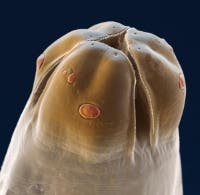Roundworms in cats
Roundworms are a common parasite of cats and can affect cats of any age, so it’s important to know what you’re up against.
Most cats will be affected by roundworm at some point in their lives; learn what you can do to help protect your cat and how to recognise the signs of roundworms in your cat.
What are roundworms?

Roundworms are one of the most common types of worm found in domestic cats; they live in your cat’s small intestine. As their name suggests, they are round but also white, cylindrical and long, looking a bit like spaghetti but with a pointed end. These worms can affect any breed of cat, at any age, though they are most common in kittens.
How do cats get roundworms?
Adult cats usually become infected through:
- hunting - rodents, birds and other small animals can be infected with the larval stages of both round and tapeworms. If cats ingest all or part of these animals, for example through hunting, they can become infected too. Feeding raw meat or some types of raw diet can also transmit both round and tapeworms to cats and dogs.
- their environment - roundworm eggs are passed out in the poo of infected cats and can lay dormant in many different places, including soil, sand pits and litter trays, and can re-infect your cat or other cats if they ingest them. This is why it’s so important to pick up cat poo from your garden, bag it and dispose of in your domestic waste, and to clean out your cat’s litter tray regularly.
Kittens can actually become infected with roundworm larvae passed on to them via their mother's milk - meaning kittens often have worms even when they've never been outside.
The signs of roundworms
Cats with roundworms often don’t show any obvious signs of discomfort, but you may notice
- a loss of appetite or vomiting
- a lack of energy, a dull or lifeless coat, a pot-bellied appearance especially in kittens
- heaving, coughing or laboured breathing
- diarrhoea, smelly poo or blood in the urine or poo
Kittens may also have slower growth as the roundworms take vital nutrients that kittens need to grow.
Risks of roundworms to humans
Importantly though, cat roundworms can also cause a disease in people called toxocariasis. If people accidentally eat roundworm eggs, the larvae of the parasite can migrate into our tissues, potentially causing serious disease. In some cases the larvae end up in the eyes, causing a condition called ocular larva migrans (OLM), which can lead to blindness. This condition is very rare, but obviously extremely serious when it does occur, and is one of the reasons that regularly worming our cats is so crucial.
How do you treat roundworms in cats?
Fortunately, worming treatments that can kill roundworms in cats and kittens are available. Speak with your vet for advice on which wormer will suit your pet best and how often it should be used.
Other measures to reduce the risks
Good hygiene is also important to help reduce the risk both to other pets and to ourselves. Wash your hands after cleaning out litter trays, and make sure all your pets are treated regularly for fleas and worms. Wash your cat’s bedding regularly, along with any blankets or cushions your cat uses for sleeping or grooming.
Did you know…
Roundworm larvae can hide out in your pet´s tissues in a dormant state, re-activating themselves at a later date. When this happens in pregnant animals, the re-activated larvae can travel to the mammary glands and infect puppies and kittens while they feed on their mother´s milk.
